Modeling of Bacterial Cellulose-Based Composite
Abstract
:1. Introduction
- (a)
- Choose a suitable bacterial strain known for its cellulose-producing ability, such as Acetobacter xylinum or other Acetobacter strains;
- (b)
- Prepare a suitable culture medium that typically contains carbon sources (glucose, sucrose), nitrogen sources (ammonium sulfate, yeast extract), mineral salts, and other necessary nutrients;
- (c)
- Inoculate the selected bacterial strain into the prepared culture medium. Allow the bacteria to ferment under controlled conditions (temperature, pH, aeration) for a specific period; during fermentation, bacteria produce cellulose as a protective exopolysaccharide layer;
- (d)
- After the fermentation period, harvest the cellulose pellicle formed at the air–liquid interface of the culture. Carefully remove the pellicle, and wash it to remove bacterial cells and culture medium components;
- (e)
- Treat the harvested cellulose pellicle with alkaline solutions (e.g., sodium hydroxide) to remove residual bacterial cells, hemicellulose, and other impurities; wash the purified cellulose thoroughly with water to neutralize the pH;
- (f)
- Dry the purified bacterial cellulose using methods like freeze-drying or air drying; store the dried bacterial cellulose in a desiccated and airtight container to prevent moisture absorption.
2. Materials and Experimental Setup
- A shaker (TIRA TV 50009) with its amplifier;
- Two laser distance sensors (Baumer OADM 12U6460/S35A);
- An accelerometer (PCB 333B40);
- A waveform generator (Keysight 33220A);
- An oscilloscope (Keysight MSO9064A);
- Two power supplies (one for the lasers and one for the accelerometer);
- The BC-based composite.
3. Modeling
- Two complex and conjugated poles fixed by the values of and : they are responsible for the peak observed in the composite frequency response;
- Two zeros: they are used to fit the module diagram out of the resonance peak;
- A zero in the origin with multiplicity used to fit the module diagram out of the resonance peak;
- A proper gain K.The following transfer function has been, therefore, considered for the identification:and the obtained parameters are listed in Table 1.
4. Identification and Experimental Results
5. Conclusions
Author Contributions
Funding
Data Availability Statement
Conflicts of Interest
Abbreviations
| BC | Bacterial cellulose |
| IL | Ionic liquids |
| PEDOT:PSS | poly (3,4-ethylenedioxythiophene) polystyrene sulfonate |
| EMIM-BF4 | 1-Ethyl-3 methylimidazolium tetrafluoroborate |
References
- Kumar, A.; Holuszko, M.; Espinosa, D. E-waste: An overview on generation, collection, legislation and recycling practices. Resour. Conserv. Recycl. 2017, 112, 32–43. [Google Scholar] [CrossRef]
- Shittu, O.; Williams, I.; Shaw, P. Global E-waste management: Can WEEE make a difference? A review of e-waste trends, legislation, contemporary issues and future challenges. Waste Manag. 2021, 120, 549–563. [Google Scholar] [CrossRef] [PubMed]
- Shahinpoor, M. Ionic Polymer Metal Composites (IPMCs)-Smart Multi-Functional Materials and Artificial Muscles. RSC Smart Mater. 2016, 12, 1. [Google Scholar]
- Lee, C.; Kim, S.; Cho, H. Silk and Paper: Progress and Prospects in Green Photonics and Electronics. Adv. Sustain. Syst. 2022, 6, 2000216. [Google Scholar] [CrossRef]
- Peng, L.; Fu, D.; Qi, H.; Lan, C.; Yu, H.; Ge, C. Micro and nano plastics in marine environment: Source, distribution and threats—A review. Sci. Total Environ. 2020, 698, 134254. [Google Scholar] [CrossRef] [PubMed]
- Jamshidi, R.; Taghavimehr, M.; Chen, Y.; Hashemi, N.; Montazami, R. Transient Electronics as Sustainable Systems: From Fundamentals to Applications. Adv. Sustain. Syst. 2022, 6, 2100057. [Google Scholar] [CrossRef]
- Zhao, D.; Zhu, Y.; Cheng, W.; Chen, Q.; Wu, Q.; Yu, H. Cellulose-Based Flexible Functional Materials for Emerging Intelligent Electronics. Adv. Mater. 2021, 33, 2000619. [Google Scholar] [CrossRef]
- Ummartyotin, S.; Manuspiya, H. A critical review on cellulose: From fundamental to an approach on sensor technology. Ren. Sust. Ener. Rev. 2015, 41, 402–412. [Google Scholar] [CrossRef]
- Ding, L.; Li, X.; Hu, L.; Zhang, Y.; Jiang, Y.; Mao, Y.; Xu, H.; Wang, B.; Feng, X.; Sui, X. A naked-eye detection polyvinyl alcohol/cellulose-based pH sensor for intelligent packaging. Carb. Pol. 2020, 233, 115859. [Google Scholar] [CrossRef]
- McNamara, J.T.; Morgan, J.L.W.; Zimmer, J. A molecular description of cellulose biosynthesis. Annu. Rev. Biochem. 2015, 84, 895–921. [Google Scholar] [CrossRef]
- IqbIqbal, H.; Kyazze, G.; Tron, T.; Keshavarz, T. Laccase-assisted grafting of poly(3-hydroxybutyrate) onto the bacterial cellulose as backbone polymer: Development and characterisation. Carbohydr Polym. 2014, 26, 113. [Google Scholar]
- Iguchi, M.; Yamanaka, S.; Budhiono, A. Bacterial cellulose – a masterpiece of nature’s arts. J. Mat. Sci. 2000, 35, 261–270. [Google Scholar] [CrossRef]
- Mangayil, R.; Rissanen, A.; Pammo, A.; Guizelini, D.; Losoi, P.; Sarlin, E.; Tuukkanen, S.; Santala, V. Characterization of a novel bacterial cellulose producer for the production of eco-friendly piezoelectric-responsive films from a minimal medium containing waste carbon. Cell 2001, 28, 671–689. [Google Scholar] [CrossRef]
- Kim, Y.; Ullah, M.W.; Ul-Islam, M.; Khan, S.; Jang, J.H.; Park, J.K. Self-assembly of bio-cellulose nanofibrils through intermediate phase in a cell-free enzyme system. Biochem. Eng. J. 2019, 142, 135–144. [Google Scholar] [CrossRef]
- Ullah, M.W.; Islam, M.U.; Khan, S.; Shah, N.; Park, J.K. Recent advancements in bioreactions of cellular and cell-free systems: A study of bacterial cellulose as a model. Korean J. Chem. Eng. 2017, 34, 1591–1599. [Google Scholar] [CrossRef]
- Ullah, M.W.; Alabbosh, K.F.; Fatima, A.; Islam, S.U.; Manan, S.; Ul-Islam, M.; Yang, G. Advanced biotechnological applications of bacterial nanocellulose-based nanohybrids: A review. Adv. Ind. Eng. Polym. Res. 2023, 2023, 4. [Google Scholar] [CrossRef]
- Klemm, D.; Cranston, E.D.; Fischer, D.; Gama, M.; Kedzior, S.A.; Kralisch, D.; Kramer, F.; Kondo, T.; Lindström, T.; Nietzsche, S.; et al. Nanocellulose as a natural source for groundbreaking applications in materials science: Today’s state. Mater. Today 2018, 21, 720–748. [Google Scholar] [CrossRef]
- Li, S.; Huang, D.; Zhang, B.; Xu, X.; Wang, M.; Yang, G.; Shen, Y. Flexible Supercapacitors based on bacterial cellulose paper electrodes. Adv. Energy Mater. 2014, 4, 1301655. [Google Scholar] [CrossRef]
- Caponetto, R.; Graziani, S.; Murgano, E.; Trigona, C.; Pollicino, A.; Di Pasquale, G. Modeling of a fractional order element based on bacterial cellulose and ionic liquids. J. Dyn. Syst. Meas. Control Trans. ASME 2021, 143, 071009. [Google Scholar] [CrossRef]
- Caponetto, R.; Di Pasquale, G.; Graziani, S.; Murgano, E.; Pollicino, A. Realization of green fractional order devices by using bacterial cellulose. AEU Int. J. Electron. Commun. 2019, 112, 152927. [Google Scholar] [CrossRef]
- Trigona, C.; Cerruto, S.; Graziani, S.; Di Pasquale, G.; Pollicino, A. Towards environmentally friendly accelerometers based on bacterial cellulose. Appl. Sci. 2021, 119, 7903. [Google Scholar] [CrossRef]
- Di Pasquale, G.; Graziani, S.; Pollicino, A.; Trigona, C. Performance Characterization of a Biodegradable Deformation Sensor Based on Bacterial Cellulose. IEEE Tran. Instr. Meas. 2020, 69, 2561–2569. [Google Scholar] [CrossRef]
- Huang, J.; Zhao, M.; Cai, Y.; Zimniewska, M.; Li, D.; Wei, Q. A Dual-Mode Wearable Sensor Based on Bacterial Cellulose Reinforced Hydrogels for Highly Sensitive Strain/Pressure Sensing. Adv. Electron. Mater. 2020, 6, 1900934. [Google Scholar] [CrossRef]
- Kuswandi, B.; Asih, N.P.; Pratoko, D.K.; Kristiningrum, N.; Moradi, M. Edible pH sensor based on immobilized red cabbage anthocyanins into bacterial cellulose membrane for intelligent food packaging. Packag. Technol. Sci. 2020, 33, 321–332. [Google Scholar] [CrossRef]
- Chen, G.; Liang, X.; Men, X.; Liu, L.; Wang, F.; Bao, X.; Zhang, H. Enhancing thermal conductivity and chemical protection of bacterial cellulose/silver nanowires thin-film for high flexible electronic skin. Int. J. Biol. Macromol. 2023, 229, 422–431. [Google Scholar] [CrossRef]
- Prilepskii, A.; Nikolaev, V.; Klaving, A. Conductive bacterial cellulose: From drug delivery to flexible electronics. Carbohydr. Polym. 2023, 313, 120850. [Google Scholar] [CrossRef]
- Aabloo, A.; Di Pasquale, G.; Graziani, S.; Kurukunda, S.; Pohako-Esko, K.; Pollicino, A.; Trigona, C. A Green Deformation Sensor Based on Bacterial Cellulose and Bio-Derived Ionic Liquids. In Proceedings of the 18th IEEE Int. Multi-Conference Systems, Signals & Devices 2021, Monastir, Tunisia, 22–25 March 2021; pp. 1182–1185. [Google Scholar]
- Di Pasquale, G.; Graziani, S.; Pollicino, A.; Trigona, C. A Bacterial Cellulose Based Mass Sensor. In Proceedings of the International Symposium on Embedded Computing and System Design (ISED), Kollam, India, 8–10 July 2019; p. 8805008. [Google Scholar]
- Di Pasquale, G.; Graziani, S.; Licciulli, A.; Nisi, R.; Pollicino, A.; Trigona, C. Geometrical and thermal influences on a bacterial cellulose-based sensing element for acceleration measurements. Acta IMEKO 2020, 9, 151–156. [Google Scholar]
- Di Pasquale, G.; Graziani, S.; Kurukunda, S.; Pollicino, A.; Trigona, C. Investigation on the role of ionic liquids in the output signal produced by bacterial cellulose-based mechanoelectrical transducers. Sensors 2021, 21, 1295. [Google Scholar] [CrossRef]
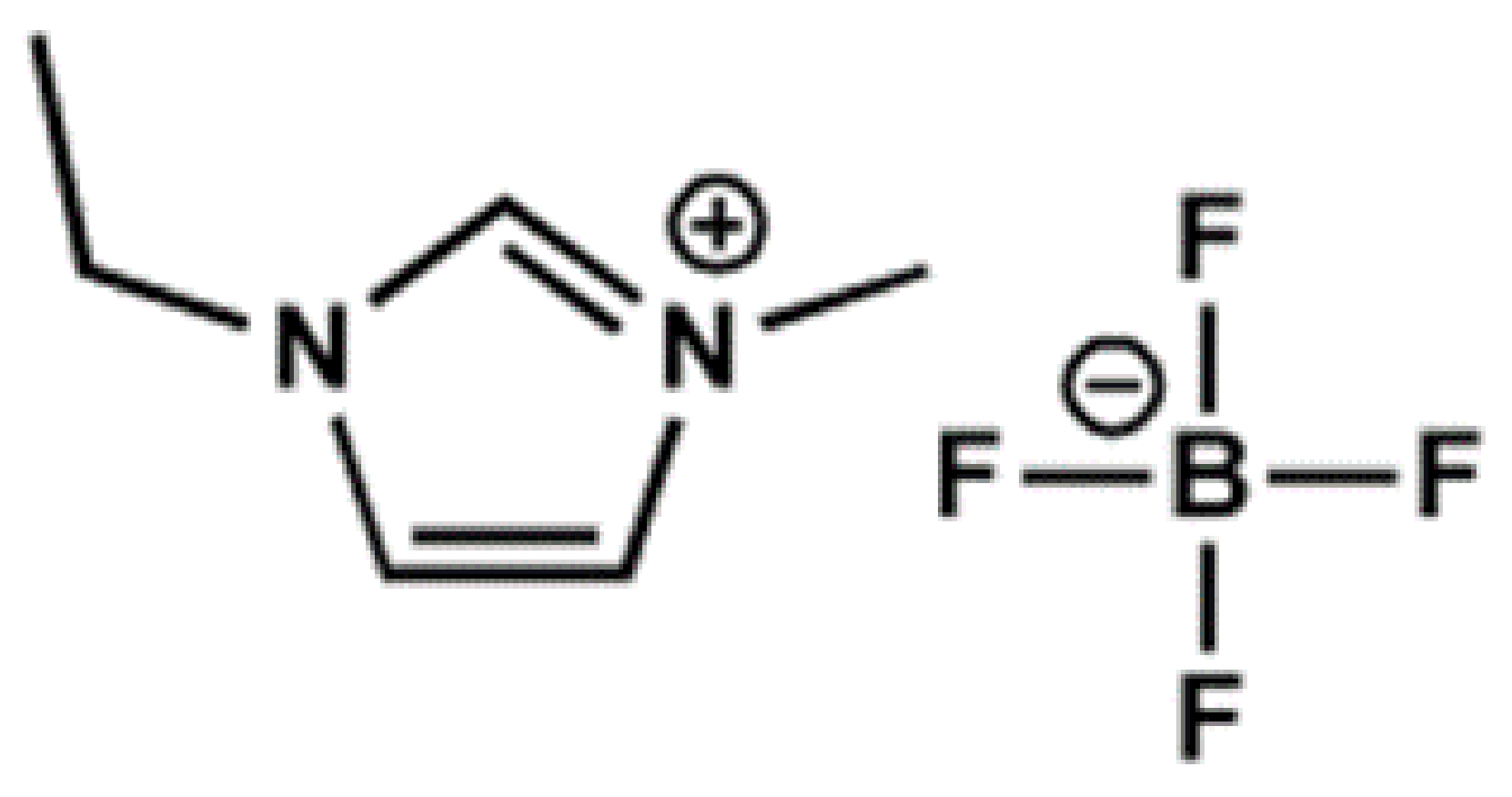
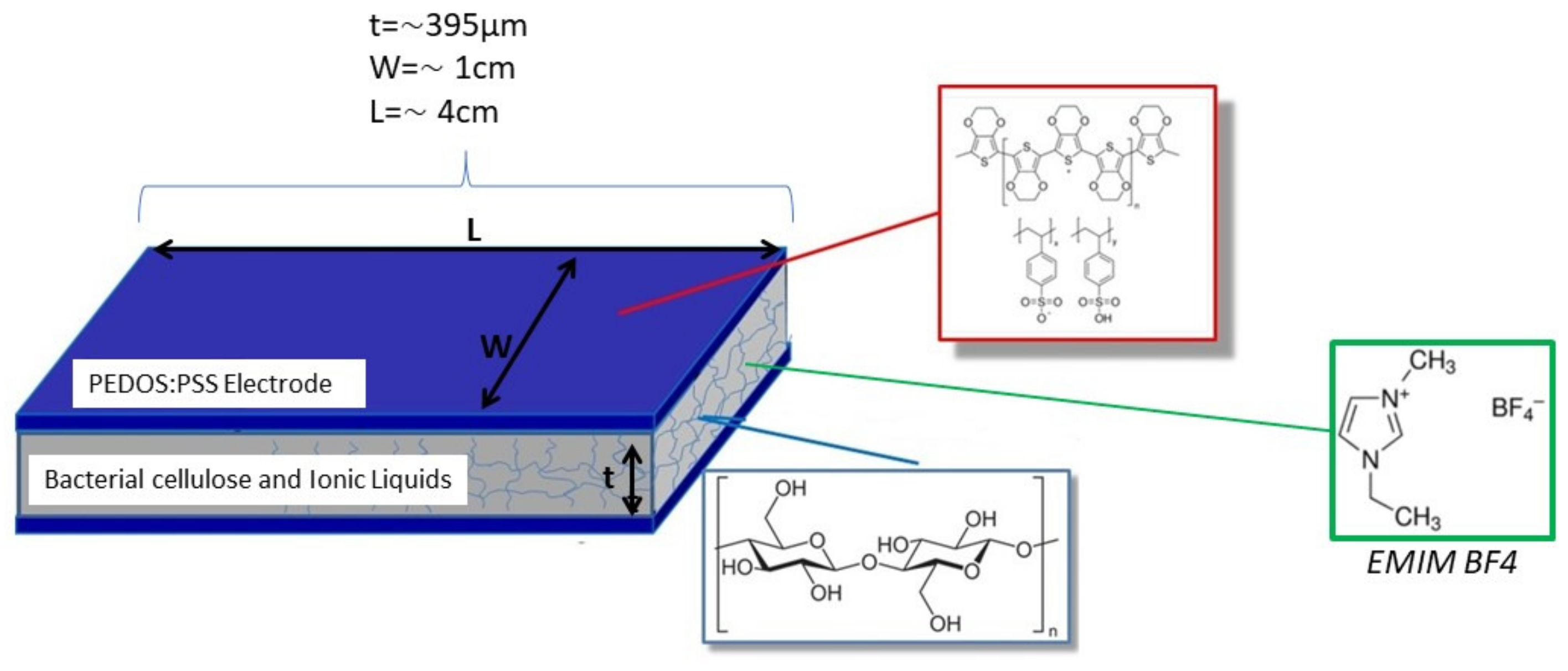
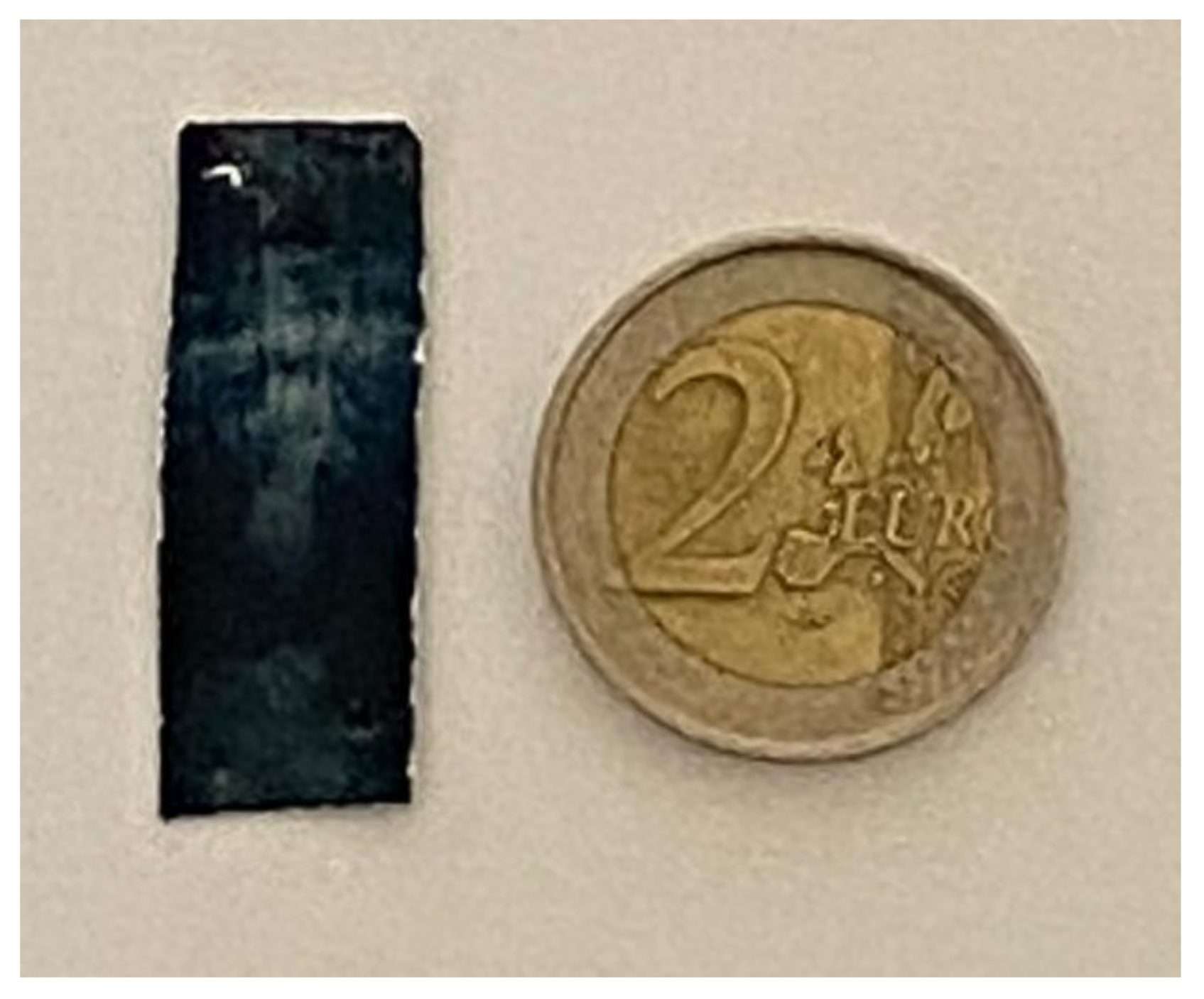
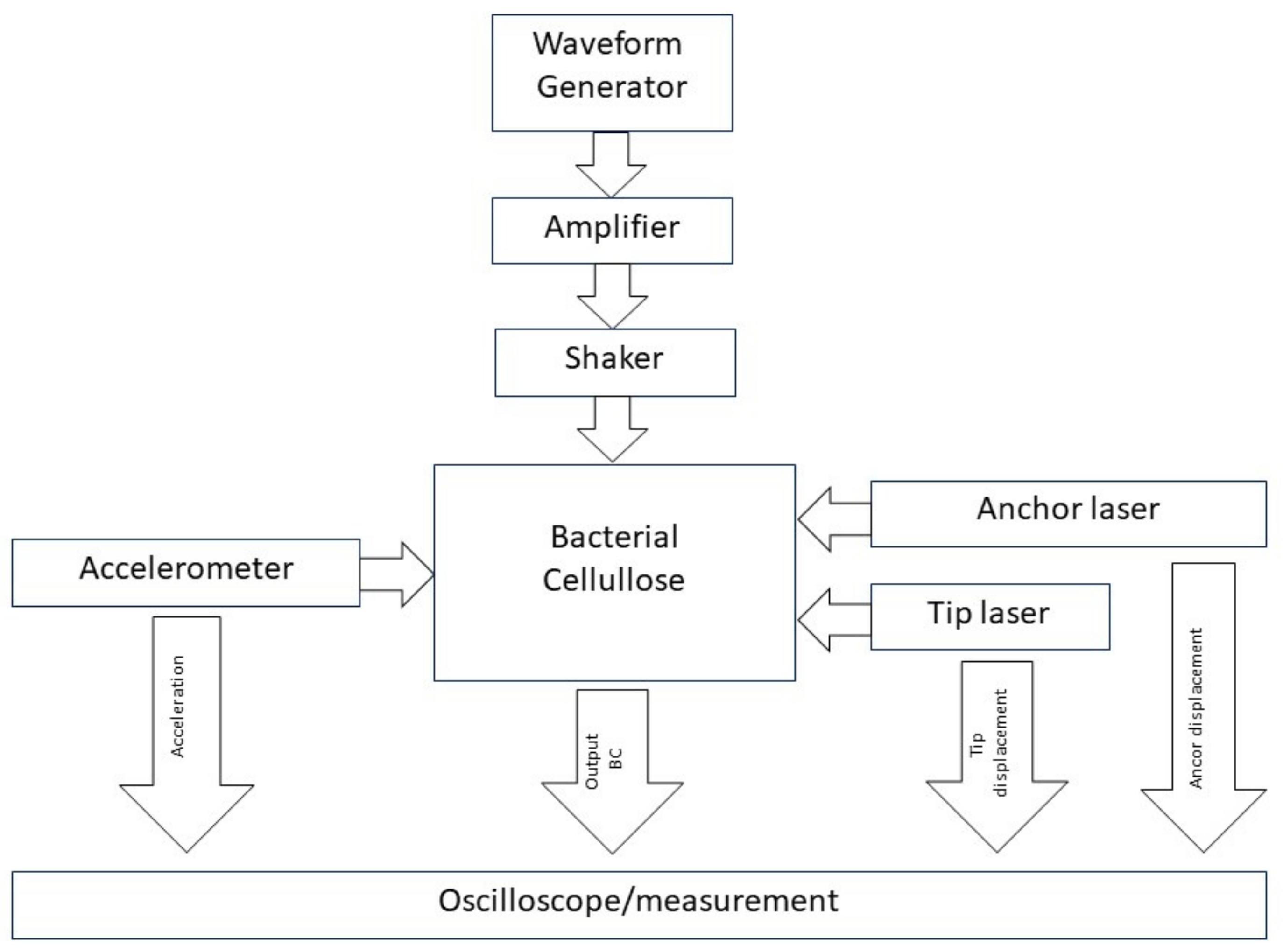




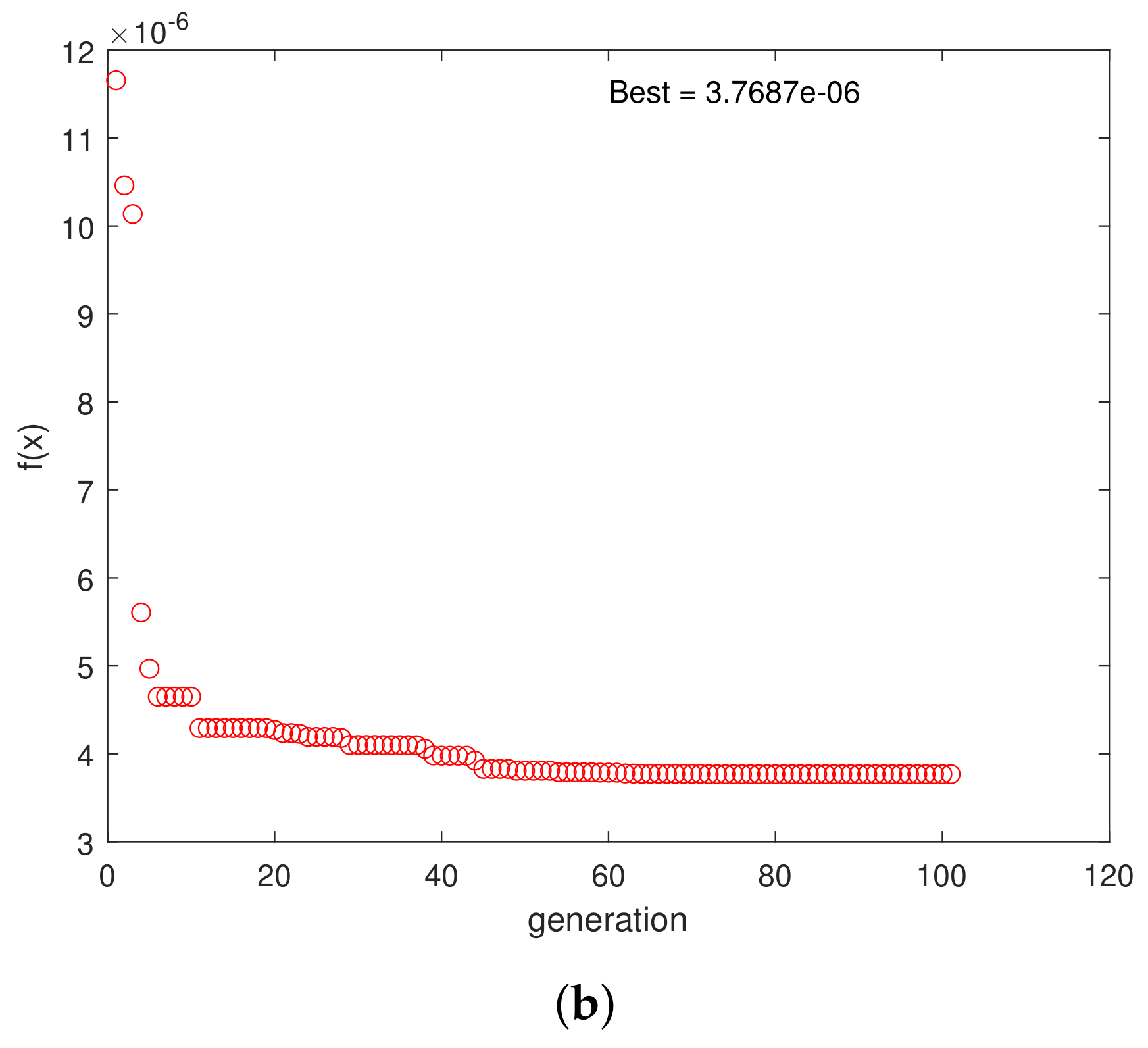
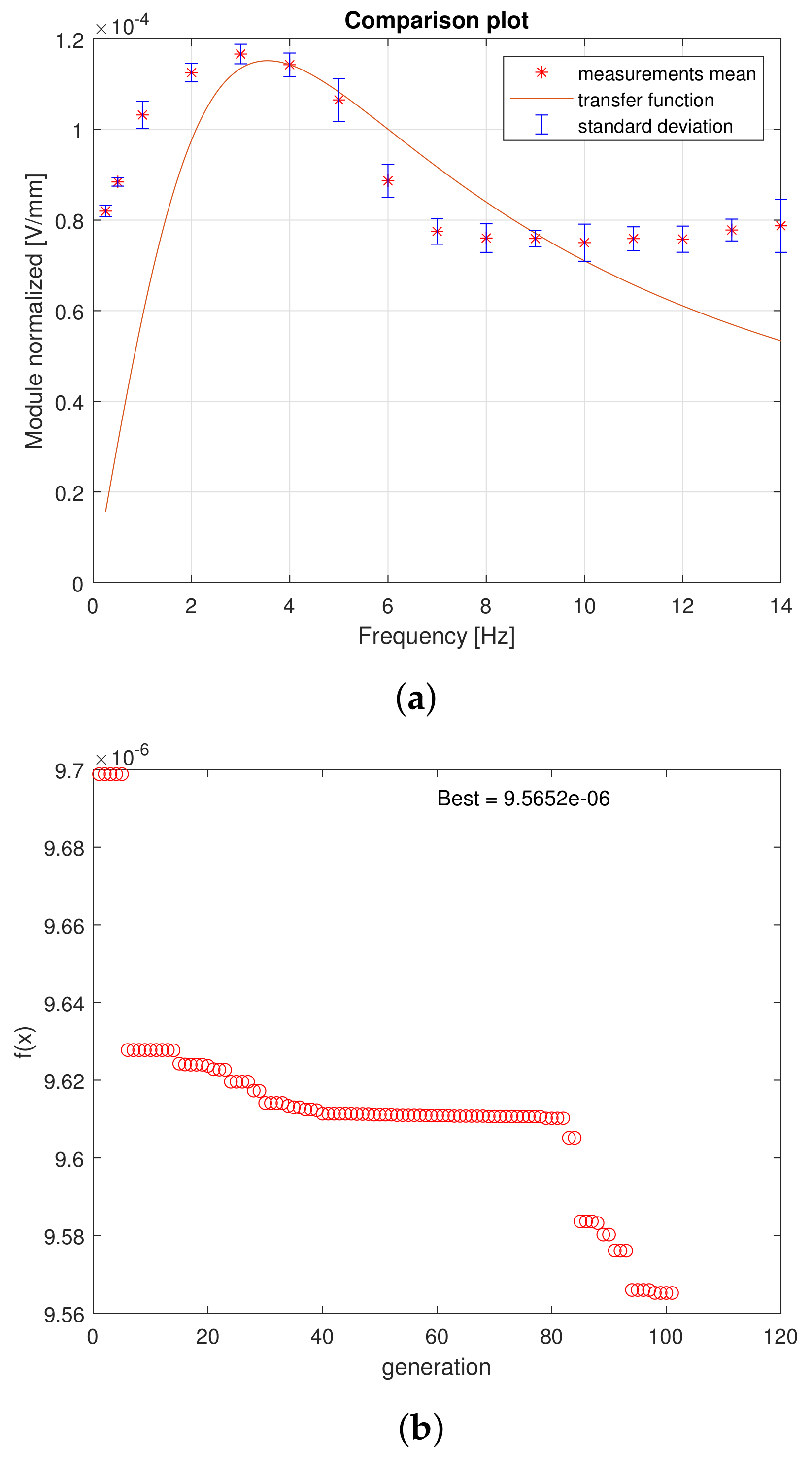

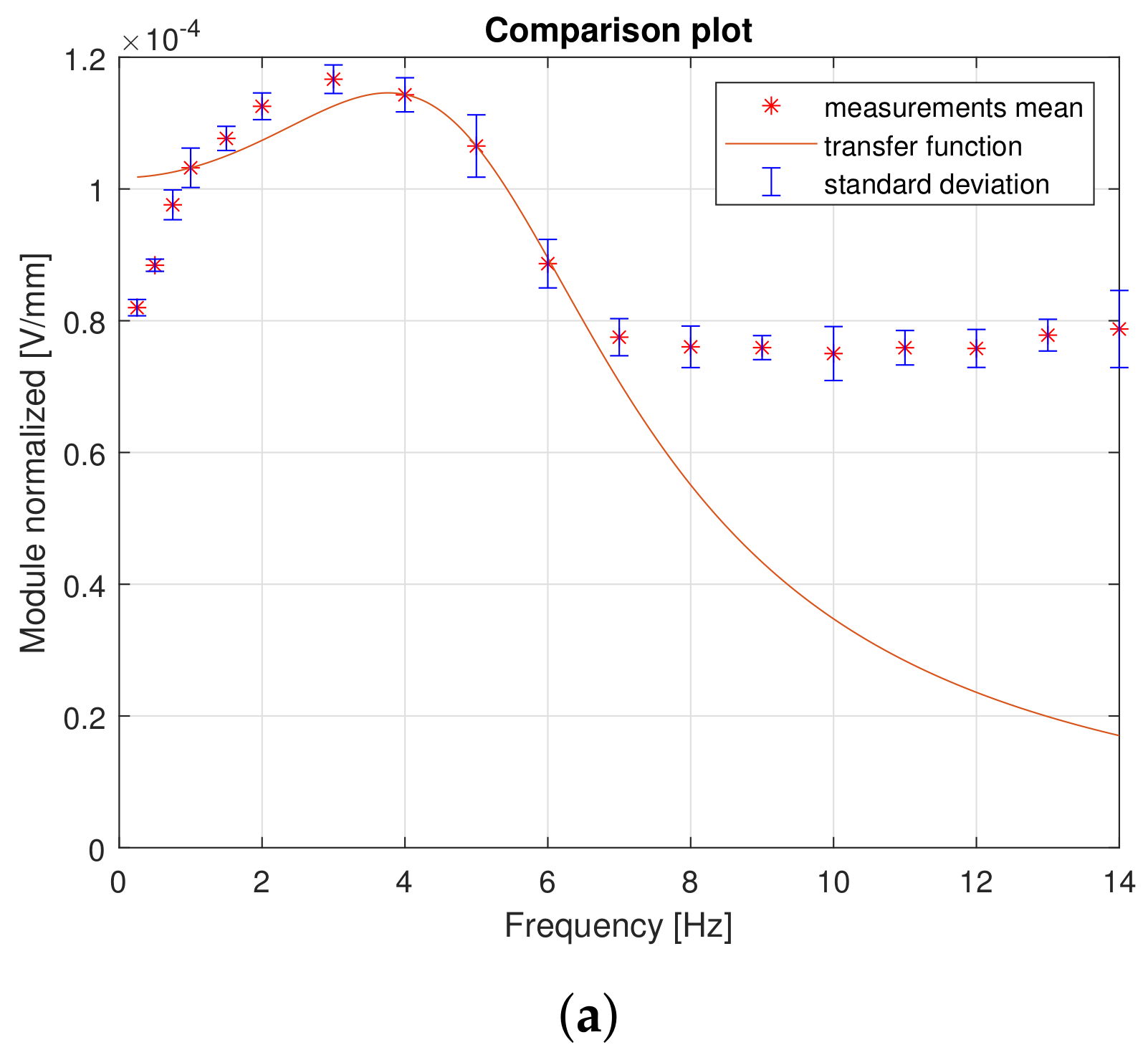
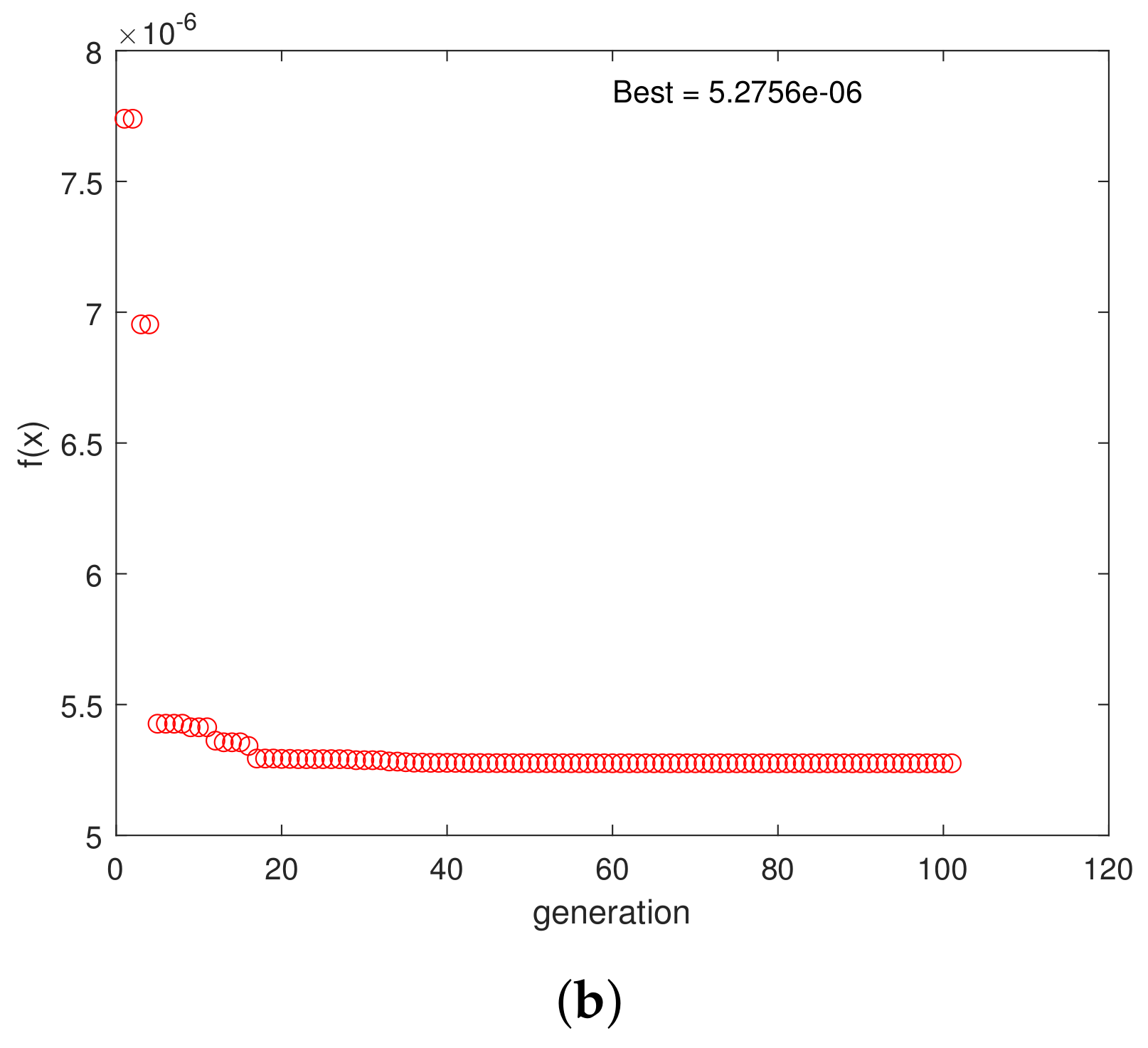

| K | E | ||||||
|---|---|---|---|---|---|---|---|
| 7.60 | 2 | n.c. | n.c. | 0.3054 | 2.1523 | 2.50 | |
| 7.03 | 0 | 3.0720 | 3.0720 | 0.6694 | 2.7440 | 3.75 | |
| 6.94 | 0 | 4.2187 | 2.2886 | 0.6904 | 2.7906 | 3.76 | |
| 7.88 | 1 | n.c. | n.c. | 0.9656 | 3.5461 | 9.56 | |
| 6.81 | 1 | n.c. | n.c. | 0.9800 | 2.8788 | 1.72 | |
| 0.0031 | 0 | n.c. | n.c. | 0.5193 | 5.5470 | 5.27 | |
| 0.0035 | 0 | n.c. | n.c. | 0.5234 | 5.8792 | 1.92 |
Disclaimer/Publisher’s Note: The statements, opinions and data contained in all publications are solely those of the individual author(s) and contributor(s) and not of MDPI and/or the editor(s). MDPI and/or the editor(s) disclaim responsibility for any injury to people or property resulting from any ideas, methods, instructions or products referred to in the content. |
© 2023 by the authors. Licensee MDPI, Basel, Switzerland. This article is an open access article distributed under the terms and conditions of the Creative Commons Attribution (CC BY) license (https://creativecommons.org/licenses/by/4.0/).
Share and Cite
Caponetto, R.; Di Pasquale, G.; Graziani, S.; Pollicino, A.; Sapuppo, F.; Trigona, C. Modeling of Bacterial Cellulose-Based Composite. Electronics 2023, 12, 4530. https://doi.org/10.3390/electronics12214530
Caponetto R, Di Pasquale G, Graziani S, Pollicino A, Sapuppo F, Trigona C. Modeling of Bacterial Cellulose-Based Composite. Electronics. 2023; 12(21):4530. https://doi.org/10.3390/electronics12214530
Chicago/Turabian StyleCaponetto, Riccardo, Giovanna Di Pasquale, Salvatore Graziani, Antonino Pollicino, Francesca Sapuppo, and Carlo Trigona. 2023. "Modeling of Bacterial Cellulose-Based Composite" Electronics 12, no. 21: 4530. https://doi.org/10.3390/electronics12214530





